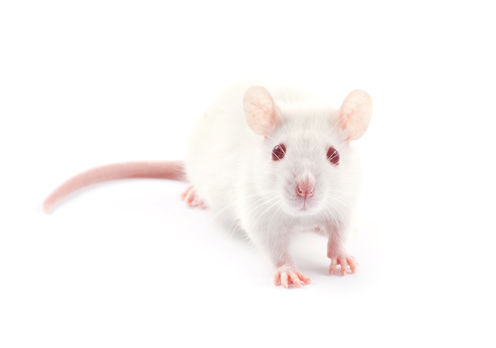
I'll have a clean cage with a side of fertility issues. Mouse image via www.shutterstock.com
By Anne-Marie Hodge, University of Wyoming
Mice possess a notable talent: they are excellent at making more mice. Their ability to reproduce at a breakneck pace is one reason they are often used as experimental research subjects. Thus, when Dr. Terry Hrubec realized that the mice in her veterinary research lab at Virginia Tech were showing sudden and dramatic declines in reproductive success, she knew she had a problem.
After combing through the literature for possible explanations, Hrubec discovered that a researcher at the University of Washington, Dr. Patricia Hunt, was having a similar experience with mice in her lab. Hrubec, Hunt, and several of their graduate students combined forces to find an explanation.
Hunt noted that a pinworm outbreak in her colony had resulted in intense cleaning efforts as staff worked to decontaminate cages and other lab equipment. Soon after, they began to notice changes in reproductive performance of the mice. Likewise, Hrubec recalled that the problems with her mice had appeared shortly after laboratory staff had started to use a similar disinfectant during routine cleaning procedures. Both disinfectants contained substances known as quaternary ammonium compounds (QACs).
Finding the culprits
The researchers tested the hypothesis that QACs were impairing lab mouse reproduction. In a small study, they exposed ten breeding pairs of mice to two QACs from their cleaning products: alkyl dimethyl benzalkonium chloride (ADBAC) and didecyl dimethylammonium chloride (DDAC). The mice ate the chemicals in their food rations, at a dosage of about 14% or 28% of their daily intake.
The results of the six-month-long experiment confirmed Hrubec and Hunt’s suspicions: exposed female mice took longer to produce their first litters, had longer intervals between litters, produced fewer pups per litter, and ultimately produced fewer total litters in a given period than did females not exposed to QACs.
Even more disturbing: forty percent of females exposed to the chemicals died either in late pregnancy or in the process of giving birth. The animals became lethargic, lost their appetites, began to lose control of their muscles, struggled to breathe and eventually suffered vaginal hemorrhaging and obstructed births, which frequently led to their deaths. The findings are reported in a recent issue of the journal Reproductive Toxicology.
Although toxic or caustic effects of QACs had been documented in the past, it seems no one had previously reported their effects on lab mouse fertility.
Dangerous combinations
QACs have been in use since the 1950s, and small amounts are found in dozens of products that most people keep in their homes, as well as research labs and hospitals across the country. They’re commonly found in products designed to be applied directly to human skin such as body lotions, hand sanitizers, cosmetics, and shampoos. They are also found in fabric softeners, hand sanitizers, and a variety of household cleaning products. Why hadn’t anyone reported these effects earlier?
First, the United States' Toxic Substances Control Act (TSCA) does not actually require that all of the ingredients used in consumer products be tested – all substances already in use when the act was passed in 1976 were grandfathered in to automatic approval without testing. The TSCA also does not classify chemicals as “toxic” or “non-toxic.” Rather, it aims to regulate the marketing and distribution of chemicals that pose “unreasonable risk to health or the environment.”
Currently, chemical safety testing – which assesses effects like physical corrosiveness as well as biological damage – has only been done on isolated QACs. This means that safety guidelines could potentially miss interactions between substances that make them more harmful when combined. By exposing mice to two QACs often used together, Hunt and Hrubec’s study highlights the importance of toxicity testing for combinations of chemicals that are frequently found in the same products, rather than basing toxicity assessments solely on isolated ingredients.
More investigation is needed
Hunt and Hrubec demonstrated that the very disinfectants that are supposed to protect laboratory animals from infection could actually be altering their biological functions. This discovery has implications for lab animal health procedures in research facilities across the globe. Scientists conducting research related to fertility and reproduction will likely be especially concerned about any chemical exposures that could affect the results of their studies.
More research on dosage-dependency and different routes of QAC exposure is needed. The mice in this study were exposed to large amounts of QACs through their food; eating food made up of 28% of any cleaning chemical seems likely to cause problems. Is there a threshold of exposure below which QAC exposure does not have these effects?
The initial observations that QAC-containing products were associated with reproductive troubles suggest that ambient exposure can be harmful, which needs to be investigated.
The effects of QACs on mouse reproduction are alarming, but it is too early to jump to conclusions about potential effects on human beings. Though there is evidence that QACs can cause bronchial problems for human beings, the jury is out on whether chronic exposure affects our fertility.
Given the vast differences in body size and reproductive patterns between mice and people, studies may show that QACs aren’t cause for fertility concerns in human beings, but Hunt and Hrubec’s initial small study will serve as a springboard to bring the issue to the public’s attention.![]()
Anne-Marie Hodge, PhD student at University of Wyoming, does not work for, consult to, own shares in or receive funding from any company or organization that would benefit from this article, and has no relevant affiliations.
This article was originally published on The Conversation. Read the original article.





Comments